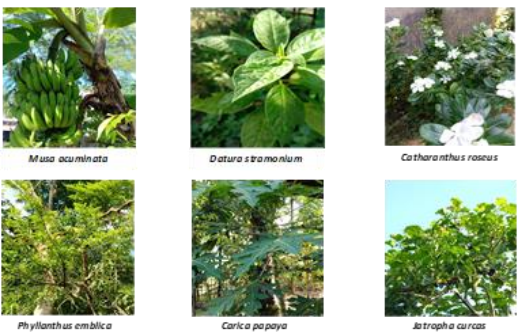Integrative Study of Traditional Medicinal Flora in Jorhat West
Keywords:
Medicinal, Flora,, Traditional, disease, anti-oxidant, anti-inflammatory, cultural practicesAbstract
The project examines the various use of these traditional medicinal plants in different fields and societies. For centuries, these plants have been used in traditional medicine, which is strongly influenced by cultural heritage, to heal various illnesses. These plants are essential for the primary healthcare systems in several parts of the world, particularly in countries such as India, Africa, and China. The research emphasizes how ethnobotany combines traditional knowledge with modern science, demonstrating its interdisciplinary nature and providing understanding on the creation of innovative pharmaceuticals. Furthermore, it explores the cultural importance and conservation of indigenous herbal remedies, stressing the need to uphold this ancestral knowledge for upcoming generations. For centuries, medicinal plants from traditional sources have been essential in healthcare for various cultures, serving as both remedies and key elements of cultural identity. These plants play a crucial role in the customs of native medicinal traditions such as Ayurveda, traditional Chinese medicine, and African traditional medicine. Preserving and documenting this knowledge is crucial, as it helps with biodiversity conservation and protecting cultural heritage.
References
P. Saha, A. D. Talukdar, S. S. Ningthoujam, M. D. Choudhury, et al., “Chemical composition, antimicrobial and antioxidant properties of seed oil plants of North-East India: A review,” TANG [Humanitas Medicine], Vol.5, Issue.2, pp.1-9, 2015.
D. Ghosh, P. K. Mukherjee, “Natural Medicines – Clinical Efficacy, Safety and Quality,” CRC Press, USA, 2025.
C. Iwaka, E. V. B. Azando, T. D. Hourhanou, S. Kora, et al., “Ethnoveterinary survey of trypanocidal medicinal plants of the Beninese pharmacopoeia in the management of bovine trypanosomosis in North Benin (West Africa),” Heliyon, Vol.9, Issue.10, e11384, 2023.
P. K. Warrier, “Indian Medicinal Plants: A Compendium of 500 Species,” Orient Blackswan Publisher, India, Vol.1, 1994.
V. Singh, R. P. Pandey, “Ethnobotany of Rajasthan,” Scientific Publishers, India, 1998.
P. K. Mukherjee, “Quality Control of Herbal Drugs,” Elsevier, Netherlands, 1st ed., 2019.
N. S. Chauhan, “Medicinal and Aromatic Plants of Himachal Pradesh,” Indus Publishing, India, 1999.
S. Vidyarthi, S. S. Samant, P. Sharma, “Traditional and indigenous uses of medicinal plants by local residents in Himachal Pradesh, North Western Himalaya, India,” International Journal of Biodiversity Science, Ecosystem Services & Management, Vol.9, Issue.1, pp.34-40, 2013.
S. Abidullah, A. Rauf, S. W. Khan, S. Mehnaz, A. Bibi, A. Rauf, S. Fazal, “Traditional uses of medicinal plants and their conservation in Charmang village, Bajaur, KP, Pakistan,” International Journal of Bioorganic Chemistry, Vol.4, Issue.2, pp.12-20, 2019.
L. M. L. Nollet, J. Ahmad, “Bioactive Compounds from Food – Benefits and Analysis,” CRC Press, USA, pp.1-500, 2024.
“Nutraceuticals in Veterinary Medicine,” Springer Science and Business Media LLC, USA, pp.1-300, 2019.
V. Kuete, “Ethnopharmacology, Phytochemistry, and Pharmacology of Potent Antibacterial Medicinal Plants from Africa,” Elsevier BV, Netherlands, pp.1-600, 2022.
J. Dlugosz, P. Staszczak, P. Smuszkiewicz-Rozanski, G. Rozanska-Smuszkiewicz, et al., “Impact of using superfood products on a sporty lifestyle,” Quality in Sport, Vol.10, Issue.2, pp.1-8, 2024.
H. N. Murthy, “Genetic Diversity of Fruits and Nuts – Sustainable Utilization,” CRC Press, USA, pp.1-400, 2025.
M. C. Gessler, D. E. Msuya, M. H. H. Nkunya, L. B. Mwasumbi, A. Schar, M. Heinrich, M. Tanner, “Traditional healers in Tanzania: the treatment of malaria with plant remedies,” Journal of Ethnopharmacology, Vol.50, Issue.3, pp.179-186, 1995.

Downloads
Published
How to Cite
Issue
Section
License

This work is licensed under a Creative Commons Attribution 4.0 International License.
Authors contributing to this journal agree to publish their articles under the Creative Commons Attribution 4.0 International License, allowing third parties to share their work (copy, distribute, transmit) and to adapt it, under the condition that the authors are given credit and that in the event of reuse or distribution, the terms of this license are made clear.






